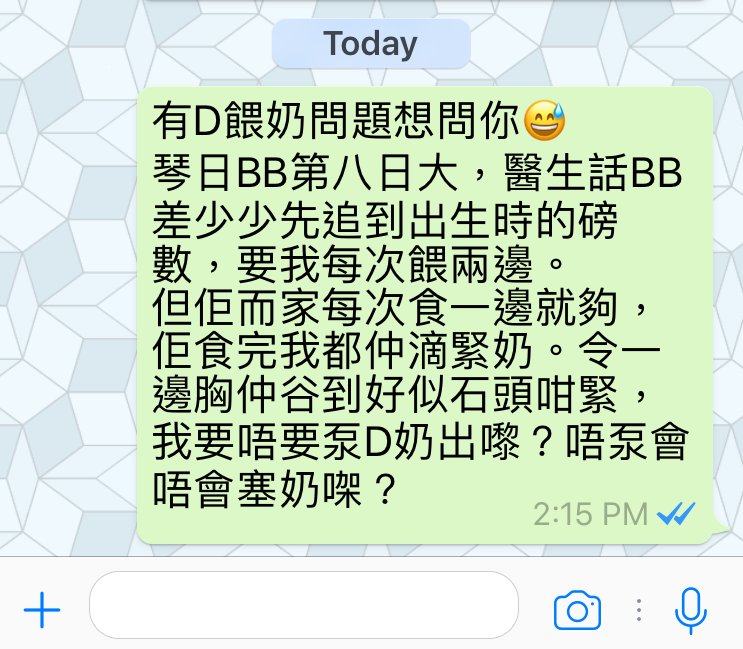| Too little Milk? Too much Milk?! |
|
Dr Amy FUNG Wai Han
MBBS(HK), Private practitioner
A healthy first time mother gave birth to her full term baby by Caesarean Section 9 days ago. She has been exclusively breastfeeding her baby 8-10 times per day since a day after the delivery. Today she asked a question via Whatsapp:
 |
 “Yesterday when my baby was 8 days old, she had not regained her birth weight. The doctor advised me to feed on both breasts in each feed. However, my baby was satisfied with one breast and milk even leaks after a feed. Should I feed her on one or both breasts per feed? “Yesterday when my baby was 8 days old, she had not regained her birth weight. The doctor advised me to feed on both breasts in each feed. However, my baby was satisfied with one breast and milk even leaks after a feed. Should I feed her on one or both breasts per feed?
Another breast is full & as hard as stone! Will the milk ducts be blocked if I do not pump out some milk?” |
- How does the body weight change in the early neonatal days and when is birth weight regained?
- How do we know if a baby is breastfeeding effectively?
- How do we assess milk supply? What about the milk supply in this mother?
- When should we advise a mother to feed on one or both breasts per feed?
Case History
This mother delivered uneventfully a full term baby with a birth weight of 3.44 Kg. She had been breastfeeding her baby on demand. In the first 2 days, the baby fed on both breasts per feed. Since milk came in on Day 3, the mother started to feed her on one breast only for most of the feeds. She had some nipple pain while the baby was suckling. The pain subsided after Day 5.
Here is a record of the baby’s body weight, urine and bowel output:
| Age |
Body weight |
Weight loss
(% of birth weight) |
No. of wet diapers
(moderately soaked) |
No. of stools
(substantial amount) |
| Day 4 |
3.25kg |
5.5% |
5 |
5 |
| Day 5 |
3.295kg |
4.2% |
6-7 |
4 |
| Day 8 |
3.4kg |
1.2% |
8 |
4 |
|
Was breastfeeding effective in this baby?
A healthy term infant has a physiological weight loss of 5-8% in the early neonatal days due to obligatory reduction of interstitial fluid. With effective breastfeeding, a baby’s weight gain of about 20-35 gram per day is achieved by Day 5 and birth weight is regained by Day 10. (Clinical Guidelines for the Establishment of Exclusive Breastfeeding, International Lactation Consultant Association, 2005)
In the first 5 days, this mother had some nipple pain while the baby was suckling. This indicated an attachment problem in the early days. This baby’s lowest weight was 3.25kg. A weight loss of 5.5% occurring on Day 4 was within the normal range. The stool and urine output were good. Both indicated effective suckling despite probable unsatisfactory attachment.
After Day 5, the pain had subsided, which reflected no more attachment problem. Her weight gain was good with 40g per day from Day 4 to Day 8 although she had not regained her birth weight by Day 8, which was again within normal limits. The stool and urine output were also good throughout. For exclusively breastfed babies, good weight gain and good output indicate adequate milk intake. In conclusion, breastfeeding was effective.
How was the mother’s milk supply?
Since mid-pregnancy, small amount of milk has been produced (lactogenesis I) and stored in the breasts. Milk volume is normally low in the first 2-3 days postpartum. On average, a significant increase in milk volume (lactogenesis II) occurs at 36-72 hours postpartum, when a mother experiences breast fullness and heaviness. This is referred to as milk “coming in”. The following 3-5 weeks is the calibration period, when milk production is calibrated according to her baby’s need. The first 2 weeks are the most sensitive period of milk calibration. Most mothers who start-off having small amount of milk will up-regulate within the calibration period. A minority starting with large amount of milk will subsequently down-regulate. Milk production is mainly under autocrine control, i.e. more milk removal results in more milk production.
In the first 2 days of milk coming in, many mothers experience some degrees of breast fullness even after the baby has finished a feed. This physiological breast engorgement or fullness usually resolves within 1-2 days. If there is persistent or even increasing breast fullness after 2 days of milk coming in, the likely causes are ineffective baby suckling, or excessive milk supply in the breast.
This mother’s milk came in on Day 3, which was a normal timing. There was no attachment problem after Day 5. Breastfeeding was effective as shown by good urine and bowel output, as well as satisfactory weight gain of 40g per day from Day 4 to Day 8. On Day 8, i.e. 5 days after milk had come in, after the baby had finished a feed on one breast, milk continued to drip from it and the other breast was mildly engorged. This suggested that the mother’s milk supply was more than baby’s need. Fortunately, this mother did not have florid signs or symptoms of engorgement or mastitis.
How should we advise the mother?
Based on the principle of autocrine control of milk production, advice on whether the baby should feed on one or both breasts per feed should depend on our assessment of mother’s milk supply. In cases of low supply, we advise feeding on both breasts per feed. For normal milk supply, we suggest a mother to finish one breast first. If her baby needs another breast, she should offer it. For this mother with potential oversupply, we would recommend one breast per feed. If the other breast is very full, she can remove a small amount of milk to relieve her discomfort and to prevent blocking. Expression on a need basis will not lead to oversupply. Probably, a few days later when milk production is further calibrated according to the baby’s need, her breasts would not be so full. By then, she would not need to express her milk anymore.
|
• Good urinary and bowel output in an exclusively breastfed baby indicates adequate milk intake. The birth weight is usually regained by Day 10
• Advice on whether a baby should feed on one or both breasts per feed depends on the mother's milk supply, e.g.
o Both breasts per feed should be advised in low supply.
- The baby should finish one breast before starting to feed on the other.
o One breast per feed in oversupply.
- A small amount of milk can be expressed from the other breast if it is very full, to relieve discomfort and prevent blockage of ducts.
|
• 全母乳餵哺的嬰兒若排出足夠的大小便,即顯示吃到足夠的母乳,並大約於10天內回復出生時的體重。
• 每次餵哺嬰兒一邊或兩邊乳房,要視乎媽媽的奶量。例如:
o 奶量偏少的媽媽須每餐餵兩邊
- 必須讓嬰兒吃完一邊乳房的奶才開始餵另一邊
o 奶量太多的媽媽則每餐只須餵一邊
- 若另一邊乳房太脹,可擠出少量乳汁以紓緩不適及防止乳管閉塞。
|
Views expressed in this article are the author's and do not necessarily reflect the opinion or position of the BFHIHKA. 作者在本文章表達的見解,未必代表愛嬰醫院香港協會的意見或立場
Editor-in-Chief: Dr Shirley Leung
Editorial Team: Dr Amy Fung , Dr Sandra Yau, Ms Iris Ip, Ms Helen Leung, Ms Agnes Wong, Ms Amy Yeung
Please click here to download the whole article and visit our website to subscribe our
E-Newsletter !
|
|